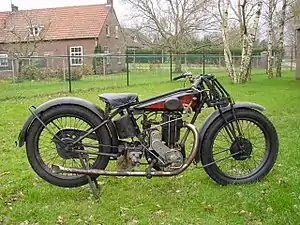Grindlay Peerless
Grindlay Peerless is a historic motorcycle manufacturer that operated out of Coventry, England, throughout the early 20th-century, specialising in racing machines including the record breaking 498cc Grindlay Peerless.[1]

Although a relatively short-lived marque, Grindlay Peerless secured a number of high-profile achievements most notably that of works rider and tuner, Bill Lacey, achieving a Fédération Internationale de Motocyclisme (FIM) world record by becoming the first man to exceed a 100 miles in an hour on British soil in August 1928 aboard his Grindlay Peerless.[2] The company quickly became renowned for building powerful, high quality and technologically advanced machines.[3][4]
The very limited number of Grindlay Peerless machines produced means that they are now extremely rare.[5]
History
In 1910, following his departure from Riley Cycle Company, Alfred Robert Grindlay and his brother, William John Grindlay (a member of the highly exclusive Coventry and Country Club) took over Coventry Motor & Sundries Co from William Edward Mann. The company was remodelled into Grindlay Sidecars, which originally began manufacturing body kits and sidecars in the early 1910s, and quickly became known for its "extremely high quality" machines.[6][7][8][9]
During WWI, Grindlay and Thomas Edward Musson combined their efforts to form the specialist sidecar manufacturer, Musson & Grindlay, operating out of Melbourne Works on Shakleton Road in Spon End, Coventry. In 1923, following the dissolution of his partnership with Musson, Grindlay and Edward Peerless formed Grindlay Peerless.[2][6] The newly formed Grindlay Peerless operating out of Melbourne Works on Shakleton Road in Spon End, Coventry, entered into the wider motorcycle market and began making high-powered machines using JAP (succeeded by Villiers), Barr & Stroud, and later Rudge-Whitworth engines.[1][10] Like the sidecars before them, the motorcycles not only had an exceptional standard of finish, including pressed monograms, elegantly shaped fuel tanks brightly plated with nickel and cadmium and luxury leather covered saddles, but were also recognised for their innovative design features. [7]
While active Grindlay Peerless produced a large number of highly regarded motorcycles, including the record beating 498cc model, but by the mid 1930s the Great Depression caused production to reduce significantly and the company dissolved in 1939.[11]
Timeline
- 1923 - Alfred Robert Grindlay and Edward Peerless form Grindlay Peerless[11]
- 1923 - Grindlay Peerless 1000cc V-twin flagship model (Barr & Stroud engine) released
- 1924 - Grindlay Peerless 488cc single OHV model (JAP engine) released
- 1925 - Grindlay Peerless 344cc, 346cc, 348cc (JAP engines) and 499cc sleeve-value models (Barr & Stroud engine) released
- 1926 - Racer Bill Lacey begins winning regularly on a tuned 344cc
- 1927 - Manufacturing focuses on the more economical 344cc, 346cc and 488cc models (JAP engines) and production of the sleeve-value models (Barr & Stroud engines) ceased
- 1927 - Bill Lacey wins a Brooklands Gold Star Award on a 498cc Grindlay Peerless
- 1928 - Grindlay Peerless 488cc model revised to 490cc and the Grindlay Peerless 677cc SV V-twin (JAP engine) and 172cc two-stroke engines (Villiers engine) released
- 1928 - Bill Lacey sets the 500cc one-hour World and British record and 103.9 miles on a modified 498cc Grindlay Peerless
- 1929 - Grindlay Peerless 500cc 'Hundred' Model (JAP engine) model released
- 1929 - Bill Lacey sets a new 500cc one-hour World and British record at 105.87pmh
- 1929 - Grindlay Peerless 490cc single OHV, 674cc single OHV and 750cc CV V-twin models (JAP engines) released
- 1930 - Grindlay Peerless 196cc and 247cc two-stroke (Villiers engines), 245cc OHV (JAP engine) and a number of variants of the 490cc OHV (JAP engine) models released
- 1931 - Produced with all V-twin engines ceased with single JAP engines retained temporarily before being replaced by Rudge-Whitworth Python engines for the 348cc 499cc models
- 1932 - Grindlay Peerless reduced their range of motorcycles to 3 models, the Tiger range, consisting of the light weight 250cc 'Tiger Cub', the mid range 499cc 'Tiger' and the top end 500cc 'Tiger Chief' and 'Tiger Chief TT' replica (Rudge-Whitworth engines)
- 1933 - Variants on the Grindlay Peerless Tiger range released
- 1934 - Grindlay Peerless limits motorcycle production and changes focus to other products
- 1939 - Grindlay and Peerless part company
The 'Hundred' Model
.jpg.webp)
Following Bill Lacey's record beating ride in 1929, Grindlay Peerless created a small number of replica motorcycles for sale to the public. The 500cc 'Hundred' model had JAP speedway engines and Webb forks as opposed to Lacey's personally tuned, twin-port engine and Brompton forks, however each motorcycle was individually tuned by Lacey's own mechanic, Wal Philips (1908 - 1998),[12] and sold with a certificate guaranteeing Lacey had personally lapped the machine at Brooklands at 100mph. Of the 6 replicas produced only 2 are known to have survived.[3][13]
Technological Advances
Grindlay Peerless adopted the use of sleeve-valve motors, a type of four-stroke engine more frequently used to power early aircraft, rather than the traditional side-valve engine, meaning that pushrods, value springs, rockers and cams were no longer required. The value operated system allowed for the spark plug to be repositioned for maximum efficiency, and required far less maintenance than a side-valve engine.[10]
Gallery
.jpg.webp) 1927 Grindlay Peerless
1927 Grindlay Peerless
References
- "Coventry Transport Museum".
- "Bonhams".
- "www.realclassic.co.uk".
- "www.realclassic.co.uk".
- "www.bonhams.com".
- "Grace's Guide to British Industrial History".
- Jackson, Colin (2013). Classic British Motorcycles. Fonthill Media.
- "A Great munitions centre: Coventry's armaments and munitions industry 1914-1918" (PDF).
- Beaven, Bradley. "The Growth and Significance of the Coventry Car Component Industry, 1895-1939" (PDF).
- "www.realclassic.co.uk". Archived from the original on 27 May 2013. Retrieved 23 June 2017.
- "www.gracesguide.co.uk".
- "www.classicmotorcycle.co.uk".
- "www.sinlesscycles.com".
External links
- Brooklands Museum - https://www.brooklandsmuseum.com/
- Age of Diesel tribute to Grindlay Peerless - http://anyskin.tumblr.com/post/148784030057/1933-grindlay-peerless-305cc
- Grindlay Peerless wins 'Best of Show Bikes' - https://www.youtube.com/watch?v=hU_DMUNDLIs
- Victor Olson describes a Grindlay Peerless - https://www.youtube.com/watch?v=aoEozIGWOH0
- Grindlay Peerless at VMCC Banbury Motorcycle Run 2016 - https://www.youtube.com/watch?v=oDXdVvPNZvo
- 1933 Grindlay Peerless - https://www.youtube.com/watch?v=hBQIJHwJ2UM